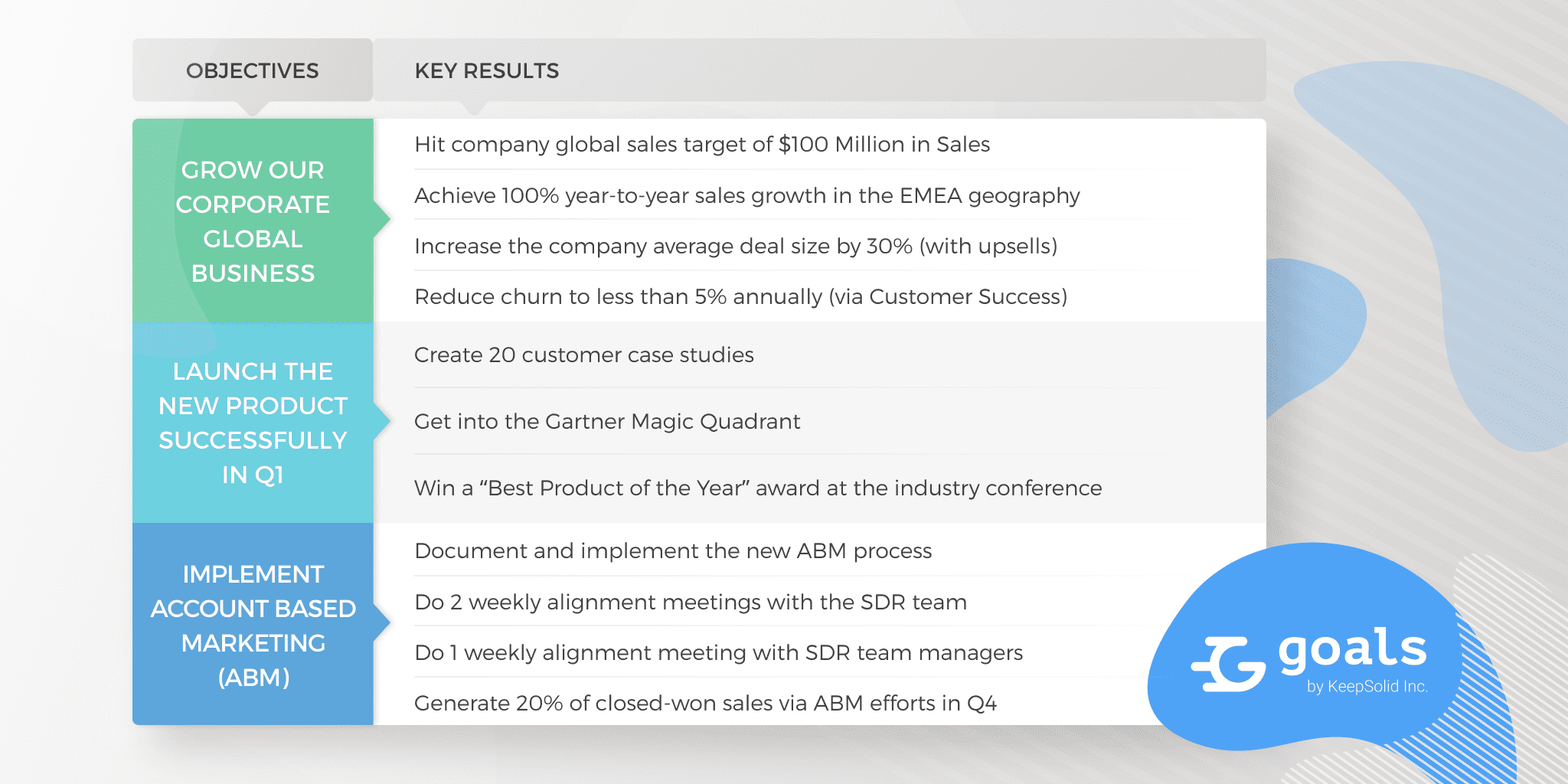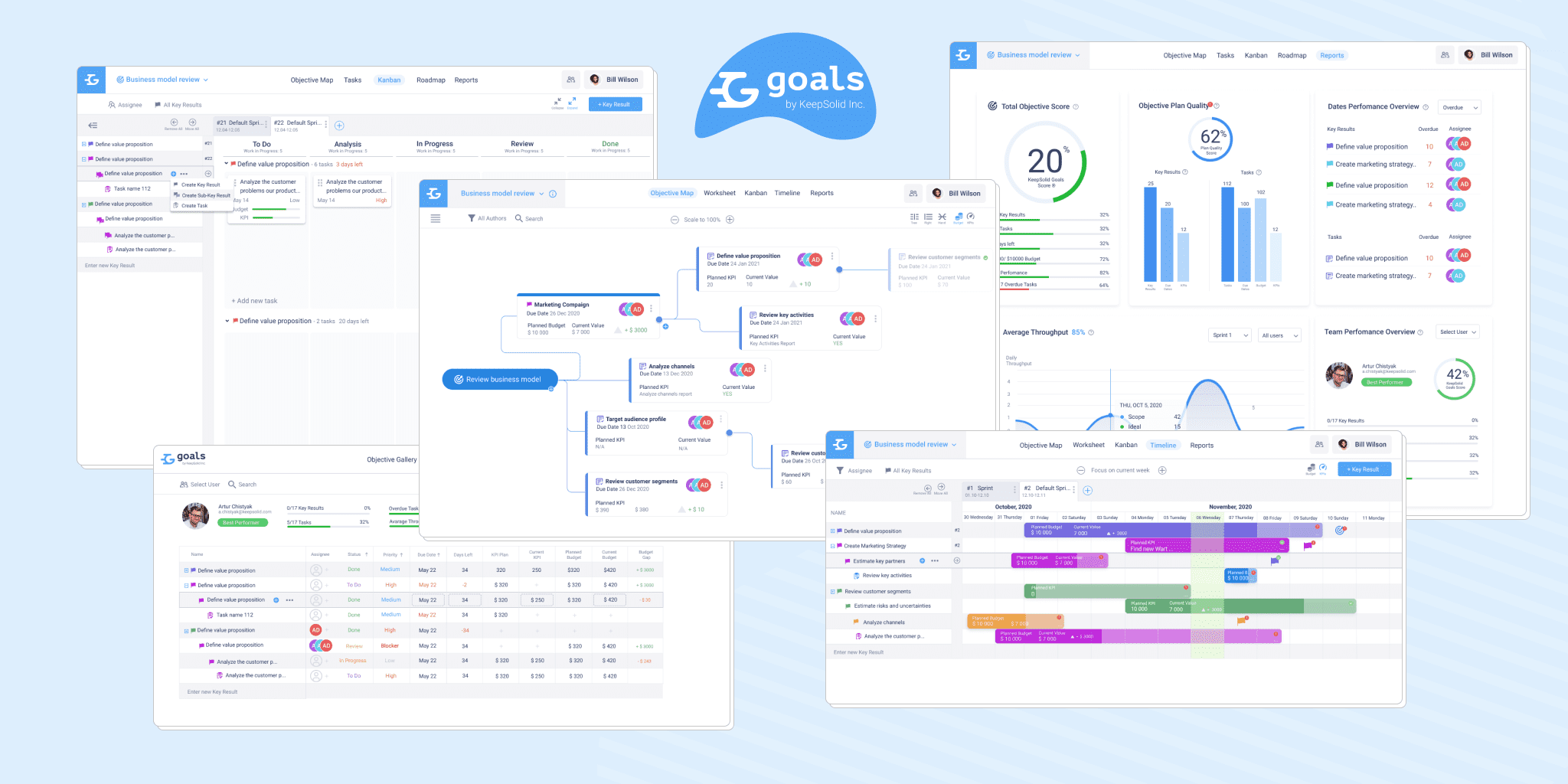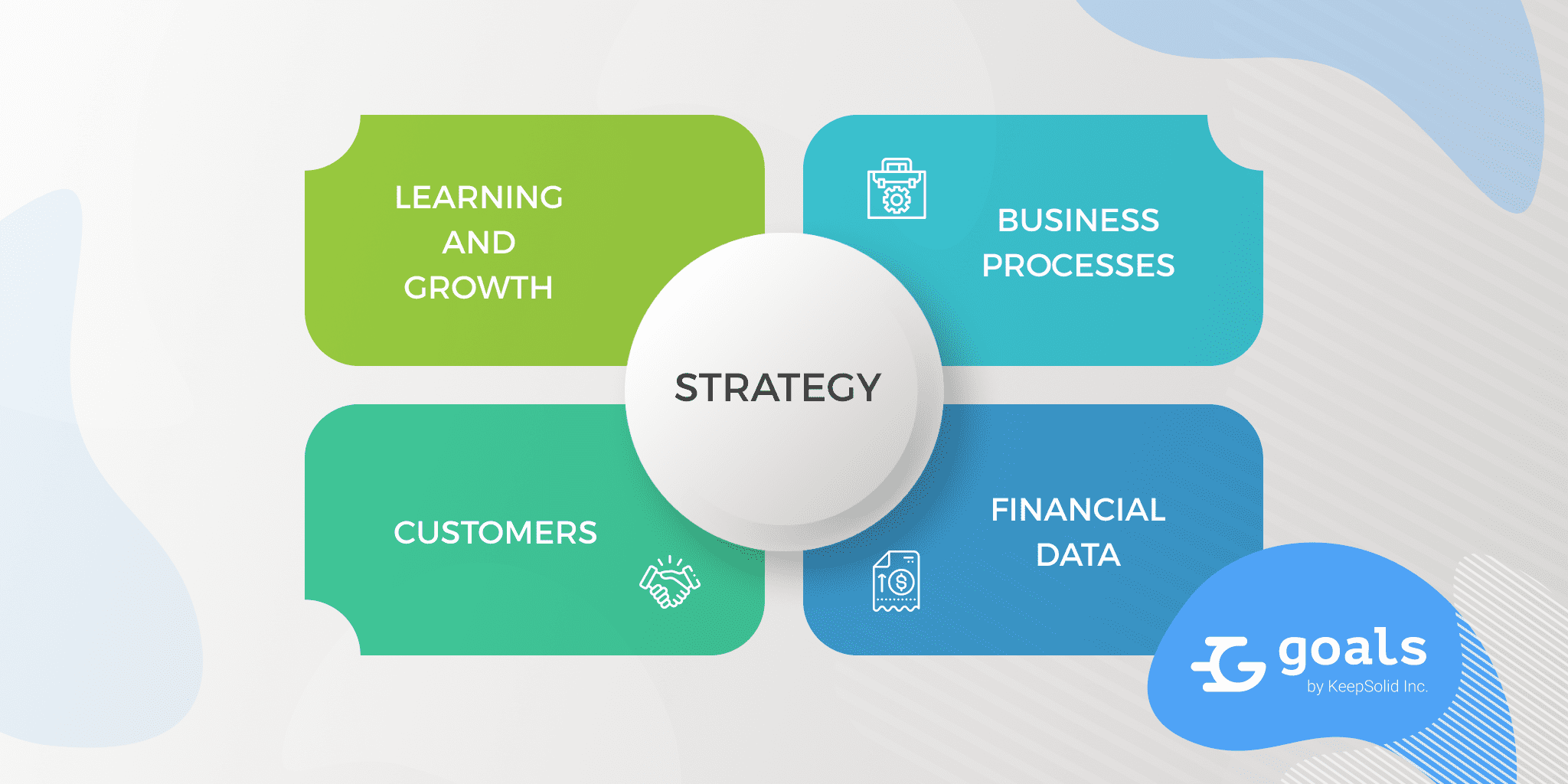Updated on Jan. 29, 2021.
Goals and objectives are two generally well-understood concepts that get more puzzling the more you think about them. What’s the difference between goals and objectives? Is there a difference, or are they the same?
In Chapter 1 we provided a general overview of the definition of goals and objectives. In this piece, we at KeepSolid Goals team would like to dive deeper into the topic to explore different interpretations of goals and objectives in different project management frameworks. We’ll discuss the differences between goals and objectives in these approaches, as well as some examples of business objectives and goals. We’ll also see which goals and objectives software you can use to succeed with your projects.
Goals and/or Objectives in Different Frameworks: Definition, Difference, Examples
One of the common reasons for the confusion regarding what are goals and objectives, and the difference between them, is probably because various business frameworks call these names different things. So if project manager A comes from the OKR background, and manager B operates under the MBO principles, they would mean vastly different things by, say, an goal.
Here’s a brief review of what business frameworks mean by objectives and goals, and how different their management may be.
| Framework | Definition of Goals and Objectives | Application of Goals and Objectives | Examples of Goals and Objectives |
| OKR (Objectives and Key Results) | Goals and objectives are synonymous - a single general, non-specific target of a business. This business framework adds a concept of Key Results, sometimes mistakenly referred to as Goals. | A single Objective is set as the main target of a company. A set of subgoals called Key Results are derived from the Objective and tied to it. This aligns all business management activities towards the common end. | Objective: Achieve record revenues while increasing profitability |
| North Star | Project goals and objectives are synonymous - long-term, high-level, and aspirational. | Used to motivate, inspire, and uplift the goal-setter, and to provide them with a general direction in project management. Works better as personal or C-level goals than as operational targets. |
Goal/Objective: Write a book and have it published |
| BSC (Balanced Scorecard) | Goals and objectives are synonymous - a specific thing a business is aiming to achieve as part of the overarching strategy. | Strategic Objectives are the actions a business must implement into its daily activities to see improvement in its strategies. They break down abstract concepts like mission and vision into actionable steps. |
Goals/Objectives: Increase margins, Increase customer satisfaction levels, Improve service delivery |
| MBO (Management by Objectives) | A Goal is what an organization is trying to achieve. An Objective is a milestone or subgoal that propels your business towards your goal. |
Goals are set by project managers for the business as a whole. SMART Objectives are then defined according to them, with employees having a say in this process, encouraging participation and commitment. |
MBO: Become the market leader, Achieve cash flow of $500,000 per month, Become a member of the fortune 500 |
Goals and Objectives in OKR
The Objectives and Key Results (OKR) approach does not differentiate between Goals and Objectives. Or more precisely, it only discusses Objectives - big, significant, action-oriented, concrete, and inspirational targets of a company. It’s implied that an objective is synonymous with a goal.
One common misconception regarding OKR is that Key Results are often called goals. That’s not correct - Key Results are the milestones that a business needs to achieve to reach its overarching Objective/Goal. They benchmark and monitor how well an organization is progressing in its project management. Effective Key Results are specific and time-bound, realistic, verifiable, and measurable. You either achieve a Key Result or you don’t, there’s no gray area.
If you’re looking for the best tool for OKR, seek no further than KeepSolid Goals! This software was developed with OKR in mind and allows project managers to create and control great action plans and strategies.

Example of OKR
Objective:
- Increase the quality of our sales approach
Key Results:
- Call back at least 50% of signups in the first 24 hours
- All sales agents should listen in to 5 product demonstrations by other team members
- Create a sales process document describing best practices with the minimum allowed service levels
KeepSolid Goals – Best OKR Goals and Objectives Software
KeepSolid Goals is a goals and objectives software that perfectly fits in the OKR approach. Here’s a quick overview of its features that will assist in your project management:
- First of all, it lets you set Objectives and Key Results, which you can neatly visualize on a mind map and get a helicopter view of the entire project.
- Goals software fosters team communication and collaboration. Having a convenient way to share ideas and collaboratively work on OKRs and drive the project to success as a team is crucial. The goals and objectives software by KeepSolid was designed exactly with this in mind.
- KeepSolid Goals offers neat features to both manage projects and monitor the projects’ progress with Kanban board, Sprints, track workload, and get reports of different types. All in all, with this goals and objectives software you can always know how’s your project going.

- The software offers simple onboarding and is easy to use. Its intuitive interface will streamline the onboarding process for your employees, help them get started with OKR methodology, and avoid common mistakes.
- Goals is a web-based software, which means it can work on any internet-capable device and thus is available to all your employees.
Given such a set of features, KeepSolid Goals is really a great one-size-fits-all OKR software for your project management.
Goals and Objectives in North Star
North Star pays little attention to goals or objectives themselves. The meat of the framework is dedicated to discovering your North Star Metric - a crucial individual or business metric that best captures the core value that your organization, service, or product delivers to your customers. This business framework also describes input metrics - factors that produce the metric, directly influenced by your teams’ day-to-day work.
Once you define your combination of North Star and input metrics, your goal/objective automatically becomes to pursue them. It is HOW you formulate the goal that is important. Since your operational and actionable targets are already described elsewhere, you want to set your goal big and inspirational. It should be a short description of your overarching strategy that will keep your focus and motivation going during many hours of work and intricate steps involved.

North Star Metric examples
For a social media or streaming service:
- Time spent actively engaging with feed
- Number of subscribers watching over 10 hours of content weekly
For an online retailer:
- Purchases per prime subscriber
- Purchases per customer session
For a SaaS product:
- Average records created per account
- Number of engaged cloud subscribers
Goals and Objectives in BSC
In the Balanced Scorecard (BSC) approach, objectives are a component of an overarching, high-level strategy. The strategy consists of 4 components:
- Objectives - continuous improvement activities of a project or business department
- Measures - KPIs that you use to evaluate your performance towards objectives
- Targets - the desired level of performance of each measure, the numbers you wish to reach
- Initiatives - specific actions that will help you achieve your targets

BSC business objective examples
- Financial: increase revenue and profitability, decrease operating costs
- Customer: improve clarity of offering, market perception, and end user experience
- Internal business processes: improve offering selection, information services, and ease of use
- Organizational: improve knowledge and skills, content supply, and technology
Goals and Objectives in MBO
As the name implies, the Management by Objectives (MBO) approach considers objectives paramount. According to it, the project management process should look like this:
- Determine or revise your company’s organizational objectives. This is a broad overview, derived from the organization’s mission and vision.
- Translate these business objectives to employees via the SMART (specific, measurable, acceptable, realistic, time-bound) approach.
- Engage employees in setting individual goals. After the organization's business objectives are shared with stakeholders, from the top to the bottom, workers should help set their own goals to facilitate said organizational objectives. According to the Management by Objectives approach, employees have a greater motivation this way, feeling a sense of empowerment.
- Monitor the employees’ progress. A key component of the business objectives you’ve set earlier is that they are measurable - that’s when you measure them! This way, you and your employees and project managers will know how well they are progressing.
- Evaluate employee progress and reward them. This includes honest feedback on their achievements (and failures).

Examples of MBO goals and objectives
Objective:
- Building a bridge
Individual goals:
- Has 6 lines
- Can carry at least 2.5M kgs
- Resists at least 8.5 Richter earth-quake
Choose the best approach for your project management, use the best goals and objectives software, and lead your business to success!



